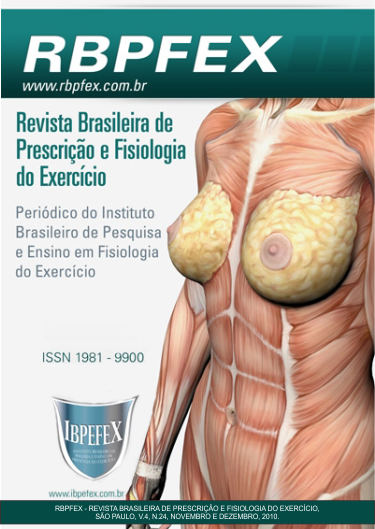Resistance exercise as a means of regulating blood pressure in hypertensive individuals
Abstract
The present study it has as objective to compare the answers of Arterial Pressure in medicated hypertensive citizens during the resisted training. For such 5 hypertensive men and 3 women with controlled hypertension for druggist and previous experience in Exercises Resisted for at least 6months had been studied. The study it was carried through in three days not consecutive during 4 weeks. First tests of 1 Maximum Repetition during the two first days had been applied, in the exercises of Straight supine, extensive chair, Scott Table, HighPulley, horizontal Leg, Triceps Pulley and Seated calf. After this in the too much days, was determined the load of work with three series of 10 repetitions 70% of 1 RM, with intervals of 1 minute between the series. The gauging of the Arterial Pressure was executed by the auscultatory method before, during and after the trainings. It was identified that during the exercise it has rise of the Arterial Pressure saw increase of the FC and cardiac debit. Analyzing the behavior of PAS, we observed statistically significant changes in BP measurements after four weeks of training, we observed a reduction of 13.19% and DBP were also observed statistically significant changes in measurements perfor-med in the same period of PAS. However we observed here anincreaseof 11.31%. However the type isotonic exercise with moderate load promotes hemodynamic, autonomic and neurohormonal, which reduce the blood pressure in post-exercise immediate and sustainable way when practiced regularly. Conclude that resistance training performed for four weeks resulted in a significant reduction in blood pressure levels.
References
-Araújo, C.G.S.; Soares C.G. Fisiologia do exercício e hipertensão arterial: Uma breve introdução. Revista hipertensão. Vol 4. Num. 3. 2001.
-Brown, L.E.; Weir, J.P. Procedures Recommendation I: Accurate Assessment Of Muscular Strength And Power. Journal of Exercise Physiology. Vol. 4. Num. 3. 2001. p. 1-21.
-Cooper, K.H. Controlando a hipertensão. 1ª edição. Rio de Janeiro. Nórdica. 1991.
-Cunha, A.C.; Rios, A.C.S.; Moreno, J.R.; Braga, P.L.; Capbell, C.S.G.; Simões. H.G.; Denadai, M.L.D.R. Hipotensão pós exercício em hipertensos submetidos ao exercício aeróbio de intensidades variadas e exercício de intensidade constante. Revista Brasileira Medicina do Esporte. Vol. 12. Num. 6.Nov/ Dez 2006. p. 313-317.
-Fleck, S.J.; Kraemer, W.J. Fundamentos do treinamento de força muscular. 2ª edição. Porto Alegre. Editora Artes Médicas Sul, 1999.
-Forjaz, C.L.M.; Rezk, C.; Melo, C.M.M.; Santos, D.A.; Teixeira, L.; Nery, S.S. Exercício resistido para o paciente hipertenso: Indicação ou contra indicação. Rev Bras Hipertens. Num. 10. 2003. p. 119-124.
-Irigoyen, M.C.; Lachhini, S.; Angelis, K.A.; Michelini, L.C. Fisiopatologia da hipertensão: O que avançamos? Revista Sociedade Cardiologia Estado de São Paulo. Num. 1. 2003. p. 20-45.
-Lopes, H.F.; Filho, J.A.S.B.; Riccio, G.M.G. Tratamento não-medicamentoso da hipertensão arterial. Revista Sociedade Cardiologia do Estado de São Paulo. Vol. 13. Num. 1. 2003. p. 148-155.
-Luna, R.L. Conceituação da hipertensão arterial e sua importância epidemiológica. Revista SOCERJ. Vol. 15. Num. 4. Out/ Nov/ Dez 2002. p. 203-209.
-Matuszak, M.E.; Fry, A.C.; Weiss, L.W.; Ireland, T.R.; Mcknight, M.M. Effect of rest interval length on repeated 1 repetition maximum back squats. Journal of Strength and Conditioning Research. Vol. 17. Num. 4. 2003. p. 634–637.
-Mediano, M.F.F.; Paravidino, V.; Simão, R.; Pontes, F.L.; Polito, M.D. Comportamento subagudo da pressão arterial após o treinamento de força em hipertensos controlados. Revista Brasileira Medicina do Esporte. Vol. 11. Num. 6.Nov/Dez 2005. p. 337-340.
-Negrão, C.E.; Pereira, A.C. Cardiologia do exercício: do atleta ao cardiopata. 2º edição revisada e ampliada. Barueri, SP. Editora Manole. 2006.
-Neto, B.T.L.; César M.C.; Tebexreni, A.S. O exercício. Preparação fisiológica, avaliação médica, aspectos especiais e preventivos. São Paulo. Atheneu, 1999.
-Pessuto, J.; Carvalho, E.C. Fatores de risco em indivíduos com hipertensão arterial. Revista Latino-am enfermagem-Ribeirão Preto. Vol. 6. Num. 1. 1998. p. 33-39
-Polito, M.D.; Farinatti, P.T.V. Comportamento da pressão arterial após exercícios contra resistência: uma revisão sistemática sobre variáveis determinantes e possíveis mecanismos. Revista Brasileira de Medicina do Esporte. Vol. 12. Num. 6. Nov-dez 2006. p. 386-392.
-Sanjuliani, A.F. Fisiopatologia da hipertensão arterial: conceitos teóricos úteis para a prática clínica. Revista SOCERJ. Vol.15. Num. 4. Out/ Nov/ Dez 2002. p. 210-219.
-Umpierre, D.; Stein, R. Efeitos hemodinâmicos e vasculares do treinamento resistido: Implicações na doença cardiovascular. Arquivo Brasileiro de Cardiologia. Vol. 89. Num. 4. 2007. p. 256-262.
-IV Diretrizes Brasileiras de Hipertensão arterial. São Paulo. BG Cultural, 2002
Authors who publish in this journal agree to the following terms:
- Authors retain the copyright and grant the journal the right of first publication, with work simultaneously licensed under the Creative Commons Attribution License BY-NC which allows the sharing of the work with acknowledgment of the authorship of the work and initial publication in this journal.
- Authors are authorized to enter into additional contracts separately for non-exclusive distribution of the version of the work published in this journal (eg, publishing in institutional repository or book chapter), with acknowledgment of authorship and initial publication in this journal.
- Authors are allowed and encouraged to post and distribute their work online (eg, in institutional repositories or on their personal page) at any point before or during the editorial process, as this can bring about productive change as well as increase impact and impact. citation of published work (See The Effect of Free Access).






